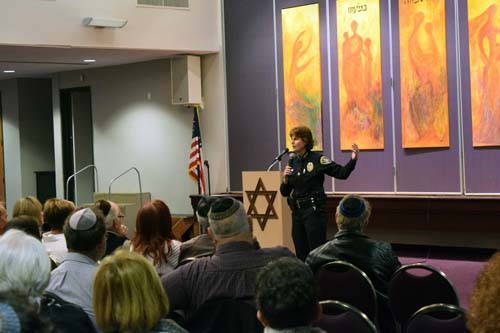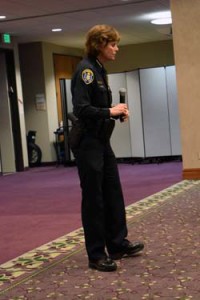
Story by Donald H. Harrison; photos by Shor Masori


SAN DIEGO — Police Chief Shelley Zimmerman said she has asked Taser International, which provides body cameras, to develop a system by which a police officer’s body camera automatically will turn on whenever he or she draws a gun from a holster.
“They are working on that and I offered to have our department be the Beta test, be the model for that, and I am hopeful that we will have that opportunity very soon,” Zimmerman said in reply to a question from Dr. Richard Braun during a question-and-answer session Monday evening, March 28, at Tifereth Israel Synagogue.
The question was put to her after the chief had answered questions from the audience about why sometimes police officers turn on the cameras and sometimes they don’t, and why she opposes automatic release of the video tapes to the news media.
In answer to another question, without mentioning U.S. Sen. Ted Cruz, R-Texas, by name, the police chief said she cringed when she heard his proposal for police to subject Muslim communities to surveillance. “What does that sound like? A little bit of Nazi Germany? Does it sound like that? Yes it does and we will not be doing this!” the Jewish police chief declared.
In extemporaneous and prepared remarks concerning body cameras, the chief said the San Diego Police Department is “seen as a leader of this technology and our department’s procedure, guidance and expertise have been sought after from many other police departments worldwide.”
She said she is proud that the Police Department is a leader in body cameras. She noted that last year the communications department of the Police Department received more than 1.4 million calls, and that officers responded to 542,000 incidents, coming into contact with millions of people. In a recent report to the City Council, she noted that complaints are down and the use of higher levels of force is down. In less than 1 percent of those incidents, specifically 0.87 percent, the police received serious complaints, she said.
“Body-worn cameras have shown what many of us in our police department and our community already knew: our officers are professionals who show care, concern and compassion for our community,” Zimmerman said. “They proudly wear our uniform and put their lives on the line to protect the citizens of our great city. I know I am grateful for all their efforts in keeping San Diego one of the safest big cities in the United States.”
To a series of questions posed by Oscar Worm about the video camera issue, Zimmerman said that when officers are confronted by someone pointing a gun at them, she wants their first instinct to be to protect themselves and the community, and not to try to turn on the video recording device. As for releasing the tapes to the media, the chief said she believes that they should be seen by the public if the matter comes to trial, when they can be considered in context with all the other evidence that might have a bearing on the case.
“Let me tell you what goes on in an officer-involved shooting,” said Zimmerman. “We first have a criminal investigation done. When that criminal investigation is done, we forward that to the district attorney who conducts another investigation to see if they are going to charge the officer or not. Then it goes to our internal affairs that looks at our policies and procedures. By the way, they get to see all the evidence, the body camera and everything else. Then it goes to an independent citizens review board on police practices, which, by the way, anyone of you here can be a member, and you also can see the video if you are a member of that independent citizens review board on police practices. Then it goes to our shooter review board that takes a look at our tactics and our training and then also the FBI conducts an independent investigation for the Department of Justice to see if that officer was justified. In addition to that if it goes to court, the judge, the jury, anyone who is inside that courtroom all get to see that piece of evidence, in context, with everybody else.”
She said that “video evidence is great evidence but it is not the piece of evidence; it is a piece of evidence. I will give you an example. Who is a football fan besides me? You watch a football game, say the Super Bowl. How many camera angles do they show to see if a player’s knee was down before they fumbled the ball? A lot. Five, six. They debate about it, and guess what, sometimes you still can’t tell. And you have to rely on the referee who made that decision in a split second. That’s a game. My officers are doing split-second decisions in real life! It can be their life, or somebody else’s life. So I think the video should be released to certain entities and we do. I don’t believe we should have trials in a public court of opinion. You know who agrees with me? Many defense attorneys because they don’t want their clients’ actions out there.”
On the issue of why officers sometimes don’t turn on body cameras, she said that 727,000 videos have been uploaded by the department compared to a few instances when officers have not done so, and asked the audience to “think about whatever your custom and practice is every morning when you wake up. Some of you are going to wake up, make a pot of coffee, go to the restroom, read the paper, make yourself some breakfast. Others of you wake up, take a shower, have a cup of coffee. Whatever your custom and practice is every morning, however long you have been doing that, imagine I said right now you are going to change your custom and practice tomorrow morning. You are now going to do this in this order. Are you going to be able to do it exactly in the new order your first time? Are you going to be able to do it perfect the first time or even the second time when someone is pointing a gun at you? It takes practice and muscle memory.”
“You know who is getting it a lot easier?” Zimmerman added. “The officers who have been on for a very short period of time, that we issued a camera in the Police Academy, so they can start to get that muscle memory, so they can start learning this new piece of equipment right from the beginning.”
She said that “if you are a leader, I tell my officers, ‘don’t be deterred by critics; do the right thing for the right reasons. Of course, you are going to protect your lives first; of course you are going to protect the community’s lives first.'”
In her answer to the question about the police and the Muslim community, Zimmerman said through community policing in that community, as well as in other communities, police learn from their regular contacts what the community concerns are.
“In our community policing philosophy, all of us work together,” said the police chief. “It is a shared responsibility of our police department and all of our communities we serve. I have spoken to the imams, I have spoken to the pastors, I have spoken to the rabbis; I speak to all our religious leaders and I tell them the same thing: that we are here to protect all of you. I tell the imams, ‘I will put a police car out there,’ just as we do here for the High Holidays, I’ve done the same thing for the mosques, the same thing for the pastors. In South Carolina when a pastor was killed, immediately I called upon pastors and said ‘look I will have cars out at your congregations.’
“No one should have to live in fear,” she said. “It shouldn’t matter who you are or where you live, you should feel safe no matter who you are or where you live. That is our community policing philosophy. … You must look at somebody’s actions not their ethnicity.”
“In our community policing philosophy, are people more apt to give us information if they know us and can see past the uniform?” Zimmerman asked rhetorically. “Yes everyone will likely tell us more and feel more comfortable if they see us as people and look past the uniform. We must be accepted in all our communities, working with all of our community members, Muslims, Jews, no matter who you are. We are proud to be one of the safest cities in our entire country so let’s all work together to make our great city even better.”
*
Harrison is editor of San Diego Jewish World. He may be contacted via donald.harrison@sdjewishworld.com. Comments intended for publication in the space below must be accompanied by the letter-writer’s first and last name and by his/her city and state of residence (city and country for those outside the United States.)
Pingback: Zimmerman event helps boost Men’s Club membership | The Ruach